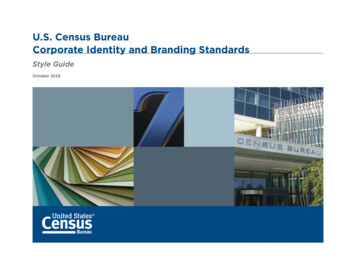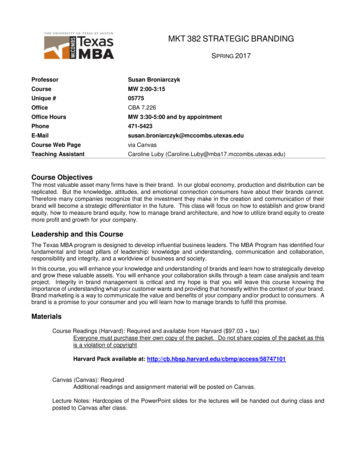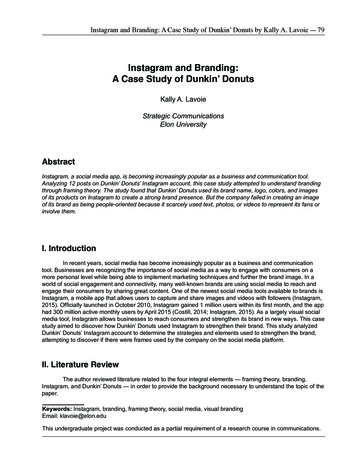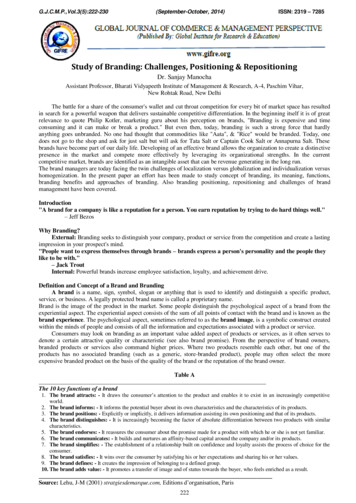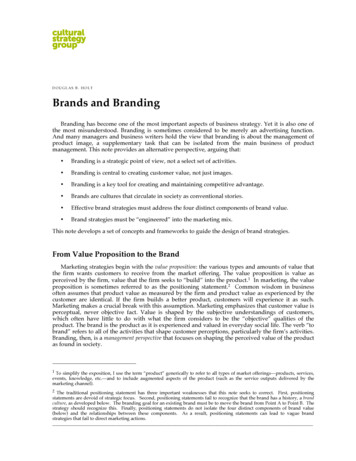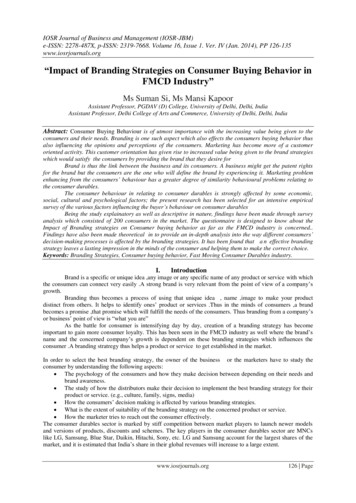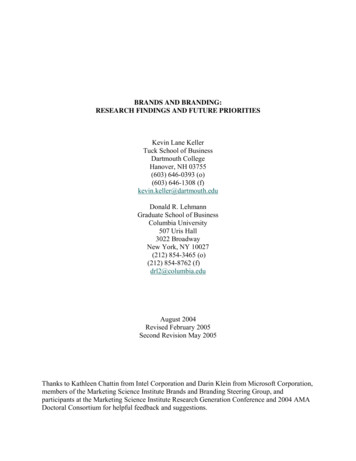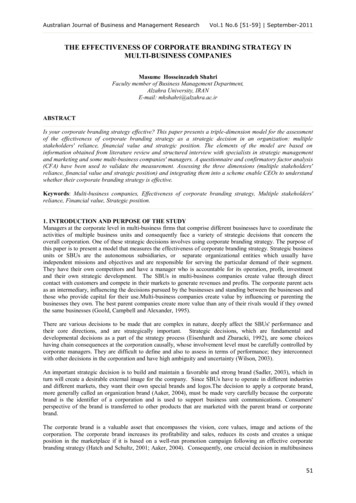
Transcription
Australian Journal of Business and Management ResearchVol.1 No.6 [51-59] September-2011THE EFFECTIVENESS OF CORPORATE BRANDING STRATEGY INMULTI-BUSINESS COMPANIESMasume Hosseinzadeh ShahriFaculty member of Business Management Department,Alzahra University, IRANE-mail: mhshahri@alzahra.ac.irABSTRACTIs your corporate branding strategy effective? This paper presents a triple-dimension model for the assessmentof the effectiveness of corporate branding strategy as a strategic decision in an organization: multiplestakeholders' reliance, financial value and strategic position. The elements of the model are based oninformation obtained from literature review and structured interview with specialists in strategic managementand marketing and some multi-business companies' managers. A questionnaire and confirmatory factor analysis(CFA) have been used to validate the measurement. Assessing the three dimensions (multiple stakeholders'reliance, financial value and strategic position) and integrating them into a scheme enable CEOs to understandwhether their corporate branding strategy is effective.Keywords: Multi-business companies, Effectiveness of corporate branding strategy, Multiple stakeholders'reliance, Financial value, Strategic position.1. INTRODUCTION AND PURPOSE OF THE STUDYManagers at the corporate level in multi-business firms that comprise different businesses have to coordinate theactivities of multiple business units and consequently face a variety of strategic decisions that concern theoverall corporation. One of these strategic decisions involves using corporate branding strategy. The purpose ofthis paper is to present a model that measures the effectiveness of corporate branding strategy. Strategic businessunits or SBUs are the autonomous subsidiaries, or separate organizational entities which usually haveindependent missions and objectives and are responsible for serving the particular demand of their segment.They have their own competitors and have a manager who is accountable for its operation, profit, investmentand their own strategic development. The SBUs in multi-business companies create value through directcontact with customers and compete in their markets to generate revenues and profits. The corporate parent actsas an intermediary, influencing the decisions pursued by the businesses and standing between the businesses andthose who provide capital for their use.Multi-business companies create value by influencing or parenting thebusinesses they own. The best parent companies create more value than any of their rivals would if they ownedthe same businesses (Goold, Campbell and Alexander, 1995).There are various decisions to be made that are complex in nature, deeply affect the SBUs' performance andtheir core directions, and are strategically important. Strategic decisions, which are fundamental anddevelopmental decisions as a part of the strategy process (Eisenhardt and Zbaracki, 1992), are some choiceshaving chain consequences at the corporation causally, whose involvement level must be carefully controlled bycorporate managers. They are difficult to define and also to assess in terms of performance; they interconnectwith other decisions in the corporation and have high ambiguity and uncertainty (Wilson, 2003).An important strategic decision is to build and maintain a favorable and strong brand (Sadler, 2003), which inturn will create a desirable external image for the company. Since SBUs have to operate in different industriesand different markets, they want their own special brands and logos.The decision to apply a corporate brand,more generally called an organization brand (Aaker, 2004), must be made very carefully because the corporatebrand is the identifier of a corporation and is used to support business unit communications. Consumers'perspective of the brand is transferred to other products that are marketed with the parent brand or corporatebrand.The corporate brand is a valuable asset that encompasses the vision, core values, image and actions of thecorporation. The corporate brand increases its profitability and sales, reduces its costs and creates a uniqueposition in the marketplace if it is based on a well-run promotion campaign following an effective corporatebranding strategy (Hatch and Schultz, 2001; Aaker, 2004). Consequently, one crucial decision in multibusiness51
Australian Journal of Business and Management ResearchVol.1 No.6 [51-59] September-2011corporations is to determine the use of corporate branding strategy, and corporations should assess whether theselected strategy effectively meets the intended outcome our not.2. LITERATURE REVIEW2.1 Corporate brandThere is an important distinction between a corporate brand and a product brand. The product brand focuses onthe product and the customer; while the marketing activity as a short, long, and tactical function handles it. Incontrast, the corporate brand clearly focuses on the whole organization where the CEO has a crucial role andultimate responsibility for its management. It considers multiple stakeholders as a strategic factor in theorganization.A corporate brand that has high complexity (Balmer, 2001) is a name, term, sign, symbol/ design or acombination of these elements, intended to identify and differentiate the company's products from those of thecompetitors in the minds of the subjects concerned (Ormeno, 2007). Essentially, it is about people, values,practices and processes (Balmer and Gray, 2003).The corporate brand contributes not only to customer-based images of the organization but to the images formedand held by all its stakeholders which are include employees, customers, investors, suppliers, partners,regulators, special interests and local communities (Hatch and Schultz, 2001, 2008). The ability to use thevision and culture of a company as part of a unique selling proposition is brought by corporate branding tomarketing (Hatch and Schultz, 2003). It also represents the agreement between the organization behind thebrand and its multiple stakeholders (Balmer, 2004). Balmer suggested that corporate brands are underpinned bythree elements: values, promises and behavior. Hatch and Schultz (2008) proposed successful corporatebranding depended on the coherence between strategic vision, organizational culture, and stockholders' image.2.2 Branding strategyBranding strategy refers to the ways that firms mix and match their brand's name on their products (Laforet andSaunders, 1999); and a firm, through its products, presents itself to the world (Aaker, 2004; Olins, 1990).Thedegree of synergy between the corporate brand and the product brand depends on the brand architecture (Kellerand Aaker, 1996; Varadarjan et al., 2006). The term "brand architecture" is sometimes used as a synonym of"branding strategy".The concept of brand architecture, which explains how multiple product brands owned by a single companyrelate to one another, helps some people understand the relationship between a product and a corporate brand(Hatch and Schoultz, 2008). Several authors have studied branding strategy and have identified some strategieswith different taxonomy, listed below:a) Individual product branding and corporate branding.b) Branded house and house of brand, including 'endorsed brands' and 'sub brands' (Aaker andJoachimstahler, 2000a).c) Endorsement branding strategy (Laforet and Saunders, 1999); strong endorsement, token endorser andlinked name (Aaker and Joachimsthaler, 2000a).d) No endorsement, weak endorsement, medium endorsement and strong endorsement (Van Riel andBruggen, 2002).e) Muzellec and Lambkin (2009) identified two types of branding strategies: integration (ascending brandextension) and separation (descending brand extension). They proposed three types of corporate brandingstrategy within the brand architecture: trade name, business brand and holistic corporate brand.f) Olins (1990) delineated three types of branding strategy that are along a continuum: monolithic strategyendorsed strategy and branded strategy.g) Kapferer (2008) distinguished some strategies that respond to the market. They are structured along twoaxes: 1) the indicator of origin source effect reassurance, and 2) product differentiation, personalizationand identification. These strategies consist of product brand, line brand, range brand, endorsing brand,source brand, umbrella brand, marker's mark, corporate endorsing brand, corporate source brand andcorporate master brand.Most companies employ mixed strategies but the paper briefly characterizes the two extremes: corporate brandstrategy and product brand strategy.2.3 Corporate branding strategyCorporate branding strategy seeks to create unique identity and position for its products, services and ensuresthat both product and organization create value beyond that of their competitors (Ind, 1997). Corporate brandingstrategy can create added value for the corporation and implement its vision and create unique position in the52
Australian Journal of Business and Management ResearchVol.1 No.6 [51-59] September-2011marketplace. Also it can enable the corporation to bring further leverage to its tangible and non-tangible assets.It is a degree of endorsement by the parent brand that has two extremes: First, the uniformity model where boththe corporate level and the business units are all positioned and profiled. Second, the variety model wherebusiness units are different from the corporate level (Van Riel and Bruggen, 2002).Van Riel and Bruggen (2002) defined the corporate branding strategy as a systematically planned andimplemented process of creating and maintaining a favorable reputation. They also said, its constituent elementsby sending signals to stakeholders used the corporate brand. Some factors impact the crafting strategy of thecorporate brand. Corporate strategy, business model, organizational culture, pace of innovation, added-valuelever, resources and brand vision are factors that should be taken into account when choosing a brandingstrategy (Kapferer, 2008).As already mentioned, there are some factors which affect successful branding strategy when the strategists ofthe organization select corporate brand strategy as a source of competitive advantage for parent and SBUs andfor obtaining the other goals of the organization. Although corporate brand strategy can be beneficial, if it is notmanaged accurately and thoroughly, both parent and SBUs can suffer losses. Consequently, a holistic approachis necessary to appraise the effectiveness of the corporate brand strategy.3. CONCEPTUAL MODELTo assess the effectiveness of corporate branding strategy, this paper proposes three dimensions that can helpthe head office understand and manage their corporate brand effectively by evaluating them. They, namelymultiple stakeholders' reliance, financial value and strategic position, determine whether a corporate brandstrategy can add significant value to the corporation and SBUs or give the corporation leverage to move itstangible and intangible assets throughout the organization.[INSERT FIGURE1]3.1. Multiple stakeholders' relianceStakeholders are all the people (and organizations or groups) that have an interest in a company, and that mayinfluence the company or be influenced by its activities. Freeman (1984) mentioned that stakeholders were anygroup or individuals who were affected by or could affect the achievement of an organization's objectives.Stakeholders are important to the organization by virtue of their ability to influence it. As a result, their viewsmust be a component of decision-making. However, some stakeholders are more powerful than others. So, thetask of management is a balancing act.Basically, one of the criteria for evaluating the effectiveness of a plan, or strategic plan is satisfaction, resultingin reliance on the part of the stakeholders. And corporate brand strategy must be developed to deliver the highestgains to all stakeholders and corporate publics. A successful organization is responsive to its critical stakeholderneeds and meets their expectations. Also, it must assess and understand their needs and expectations continuallyand anticipate their changeable expectations.In relation to corporate branding strategy as a corporate level subject, the main difference between product andcorporate branding is the target of branding. The product branding target is one consumer or consumer segmentwith a single message while the target of corporate branding is multiple audiences with a key single messagethat is meaningful to all, although each constituency may regard the message differently. It is this multipliereffect that gives the corporate branding program its power (Gregory and Wiechmann, 1997).The corporationsthat use corporate brand strategy distinguish themselves from their competitors and differentiate themselves inthe minds of their stakeholders (Balmer, 2004).Van Riel and Bruggen (2002) presented the SIDEC model that suggests under which conditions SBU managersare willing to support a uniform corporate branding strategy and under which conditions they prefer to use anautonomous branding strategy. Corporate brands focus on building relationships with multiple stakeholdergroups in order to create a stable image of corporation products and services.3.2. Financial valueBrands as an intellectual capital are widely considered as an important contributor to business performance andeconomic growth and ultimately economic performance. Furthermore, brand strategy is a significant factor inthe financial success of a corporation. Branding strategy has an impact on a firm's financial performance(Zyglidopoulos et al., 2006; Alessandri and Alessandri, 2004; Olins, 1990).53
Australian Journal of Business and Management ResearchVol.1 No.6 [51-59] September-2011Gregory and Wiechmann (1997) pointed out that there were data that linked corporate branding with increasedsales, increased market share, increa
Several authors have studied branding strategy and have identified some strategies with different taxonomy, listed below: a) Individual product branding and corporate branding. b) Branded house and house of brand, including 'endorsed brands' and 'sub brands' (Aaker and Joachimstahler, 2000a). c) Endorsement branding strategy (Laforet and Saunders, 1999); strong endorsement, token endorser
